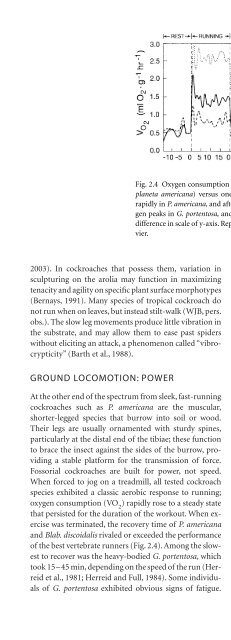Cockroache; Ecology, behavior & history - W.J. Bell
Cockroache; Ecology, behavior & history - W.J. Bell
Cockroache; Ecology, behavior & history - W.J. Bell
Create successful ePaper yourself
Turn your PDF publications into a flip-book with our unique Google optimized e-Paper software.
Fig. 2.4 Oxygen consumption while running on a treadmill: a cockroach built for speed (Periplaneta<br />
americana) versus one built for power (Gromphadorhina portentosa). Oxygen peaks<br />
rapidly in P. americana, and afterward the insect recovers rapidly. There is a lag time before oxygen<br />
peaks in G. portentosa, and a slow recovery time while the insect “catches its breath.” Note<br />
difference in scale of y-axis. Reprinted from Herreid and Full (1984), with permission from Elsevier.<br />
2003). In cockroaches that possess them, variation in<br />
sculpturing on the arolia may function in maximizing<br />
tenacity and agility on specific plant surface morphotypes<br />
(Bernays, 1991). Many species of tropical cockroach do<br />
not run when on leaves, but instead stilt-walk (WJB, pers.<br />
obs.). The slow leg movements produce little vibration in<br />
the substrate, and may allow them to ease past spiders<br />
without eliciting an attack, a phenomenon called “vibrocrypticity”<br />
(Barth et al., 1988).<br />
GROUND LOCOMOTION: POWER<br />
At the other end of the spectrum from sleek, fast-running<br />
cockroaches such as P. americana are the muscular,<br />
shorter-legged species that burrow into soil or wood.<br />
Their legs are usually ornamented with sturdy spines,<br />
particularly at the distal end of the tibiae; these function<br />
to brace the insect against the sides of the burrow, providing<br />
a stable platform for the transmission of force.<br />
Fossorial cockroaches are built for power, not speed.<br />
When forced to jog on a treadmill, all tested cockroach<br />
species exhibited a classic aerobic response to running;<br />
oxygen consumption (VO 2<br />
) rapidly rose to a steady state<br />
that persisted for the duration of the workout. When exercise<br />
was terminated, the recovery time of P. americana<br />
and Blab. discoidalis rivaled or exceeded the performance<br />
of the best vertebrate runners (Fig. 2.4). Among the slowest<br />
to recover was the heavy-bodied G. portentosa, which<br />
took 15–45 min, depending on the speed of the run (Herreid<br />
et al., 1981; Herreid and Full, 1984). Some individuals<br />
of G. portentosa exhibited obvious signs of fatigue.<br />
They stopped, carried their body closer to the substrate,<br />
and had a hard time catching their breath: respiratory<br />
movements were exaggerated and the insects maintained<br />
their spiracles in a wide-open position.<br />
Burrowing<br />
Digging <strong>behavior</strong> in cockroaches has not been studied,<br />
but the little, mostly anecdotal information we have indicates<br />
substantial variation, both in the <strong>behavior</strong> employed<br />
and in the body part used as a digging tool. There<br />
are at least two modes of creating tunnels in a hard substrate<br />
(soil, wood), both of which are accomplished by<br />
moving the substrate mechanically from in front of the<br />
insect and depositing it elsewhere. There are also two<br />
methods of digging into more friable material (guano,<br />
leaf litter, sand), achieved by insinuating the body into or<br />
through preexisting spaces. <strong>Cockroache</strong>s use refined excavation<br />
and building techniques in burying oothecae<br />
(Chapter 9).<br />
Scratch-Digging (Geoscapheini)<br />
All members of the uniquely Australian Geoscapheini excavate<br />
permanent underground living quarters in the<br />
compact, semi-arid soils of Queensland and New South<br />
Wales. The unbranched burrows of M. rhinoceros can<br />
reach a meter beneath the surface (Chapter 10); the tunnel<br />
widens near the bottom into a compartment that<br />
functions as a nursery and a storage chamber for the dried<br />
vegetation that serves as food. The distal protibiae are impressively<br />
expanded to act as clawed spades, driven by the<br />
LOCOMOTION: GROUND, WATER, AND AIR 21


